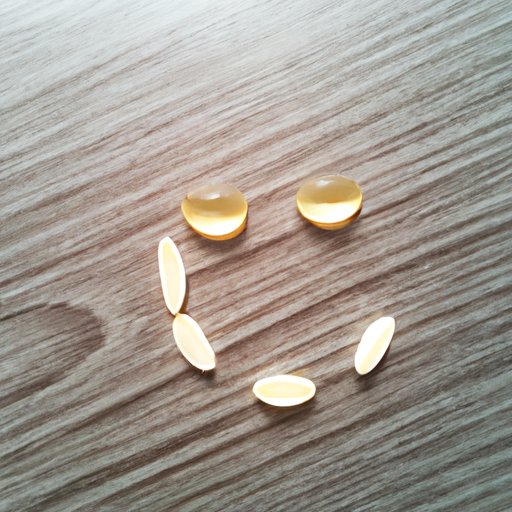
Introduction
Vitamin D is a fat-soluble vitamin that is essential for many bodily functions, including bone health, immune system regulation, and skin health. The primary source of vitamin D is exposure to sunlight, but it can also be found in certain foods or supplements. Hair loss, on the other hand, is a condition that affects the hair follicles and results in hair thinning or baldness. Hair loss can be caused by various factors, such as hormonal imbalances, autoimmune disorders, stress, or nutrient deficiencies.
In recent years, several studies have investigated the correlation between vitamin D levels and hair health. Some researchers suggest that low vitamin D levels may be a contributing factor in hair loss, especially in people who are genetically predisposed to this condition. Thus, it is essential to understand the link between vitamin D and hair loss and to identify ways to prevent or treat this problem.
Connection Between Low Vitamin D Levels and Hair Loss
Scientific evidence suggests that vitamin D plays a critical role in hair follicle cycling, which is the process of hair growth, shedding, and regeneration. Vitamin D receptors are present in hair follicles and sebaceous glands, indicating that this vitamin has an impact on hair growth regulation, follicular stem cell maintenance, and sebum production.
Research studies have shown a correlation between low vitamin D levels and various hair disorders, such as alopecia areata, telogen effluvium, and female-pattern hair loss. A 2014 study published in the International Journal of Trichology found that patients with alopecia areata had significantly lower levels of serum vitamin D compared to healthy controls. Another study conducted in 2017 by the University of Cairo revealed that women with female-pattern hair loss had lower levels of serum vitamin D than women without hair loss. Although these studies do not prove a causal relationship between low vitamin D levels and hair loss, they suggest that there may be a connection.
Symptoms and Causes of Vitamin D Deficiency
Vitamin D deficiency is a prevalent health issue in many countries, especially in regions with limited sun exposure or high pollution. Vitamin D deficiency can have various symptoms, such as muscle weakness, fatigue, bone pain, and mood disorders. However, vitamin D deficiency can also manifest in hair loss, as this vitamin is essential for the maintenance of hair follicles.
The primary cause of vitamin D deficiency is inadequate sun exposure, which hinders the synthesis of vitamin D in the skin. Other factors that can contribute to vitamin D deficiency include a poor diet, specific medical conditions, certain medications, and age. People who follow a vegan or vegetarian diet, have dark skin, or live in northern latitudes may be more prone to vitamin D deficiency than others.
When the body lacks vitamin D, it can affect the hair growth cycle and lead to hair loss. Vitamin D deficiency can trigger an autoimmune response that attacks hair follicles, resulting in hair loss. Moreover, low vitamin D levels can cause an imbalance in calcium and phosphorus levels, affecting bone and hair health.

Guidance on How to Prevent Vitamin D Deficiency
Preventing vitamin D deficiency is essential for overall health and wellbeing. The daily requirements of vitamin D vary depending on age, gender, and health status. For adults, the recommended daily intake of vitamin D is 600-800 IU, although some experts suggest that higher doses may be necessary for people with vitamin D deficiency or specific health conditions.
There are various ways to boost vitamin D intake naturally. Sunlight is the best source of vitamin D, and experts recommend spending 10-15 minutes in the sun during peak hours (before 10 am or after 3 pm) to get enough vitamin D. However, excessive exposure to sunlight can also cause skin damage, so it is essential to use sunscreen and avoid prolonged sun exposure.
Foods that are rich in vitamin D include fatty fish (such as salmon, tuna, or mackerel), egg yolks, fortified milk or cereal, and mushrooms. However, it may be challenging to get enough vitamin D from food alone, especially for people who follow a restricted diet or have absorption issues.
Therefore, vitamin D supplements can be a useful option for people who are not getting enough vitamin D from sunlight or food. Supplements come in various forms, such as capsules, tablets, or drops, and should be taken under the guidance of a healthcare professional.
Improving Hair Health by Increasing Vitamin D Intake
Increasing vitamin D intake may enhance hair health and prevent or slow down hair loss caused by nutrient deficiencies. Incorporating foods that are high in vitamin D into the diet can be a good way to boost vitamin D levels. As mentioned earlier, fatty fish, egg yolks, and fortified milk or cereal are all excellent sources of vitamin D.
Vitamin D supplements are another option that can help improve hair health. Supplements should be taken according to their formulation and dosage, and it is essential not to exceed the daily recommended intake, as high doses of vitamin D can cause adverse effects (such as hypercalcemia).
However, it is also essential to remember that hair health is not dependent on vitamin D alone. A balanced diet that includes other essential nutrients (such as protein, iron, biotin, and zinc) is necessary for hair growth and maintenance. Consult with a healthcare professional or a registered dietitian to develop a balanced diet plan that fits your specific needs.
Tips and Tricks on Identifying Hair Loss Resulting from Vitamin D Deficiency
If you suspect that your hair loss may be caused by vitamin D deficiency, there are several ways to identify it. A blood test can measure your serum vitamin D levels and determine if you are deficient in this vitamin. The normal range of vitamin D in the blood is between 30 and 100 ng/mL, but some experts suggest that optimal levels should be between 40 and 60 ng/mL for proper hair health.
In addition, hair loss caused by vitamin D deficiency may show specific physical signs, such as hair thinning or breakage, scalp dryness or itchiness, or an increase in hair shedding. However, these symptoms may also be caused by other factors, so it is essential to seek advice from a healthcare professional for proper diagnosis and treatment.
The Role of a Balanced Diet in Improving Hair Health
A balanced diet that provides essential nutrients for hair growth and maintenance is crucial for hair health. Specific food groups, such as protein, iron, biotin, and zinc, are required for hair follicle function and cell growth. Protein is essential for the formation of keratin, the primary component of hair structure, while iron is critical for oxygen transportation to hair follicles.
Moreover, a healthy diet that includes fruits, vegetables, whole grains, and lean proteins can provide antioxidants and anti-inflammatory compounds that promote overall health and reduce stress levels, which can contribute to hair loss.
Conclusion
In conclusion, low vitamin D levels can be a contributing factor in hair loss, especially in people who are genetically predisposed to this condition. Vitamin D plays a critical role in hair follicle cycling and growth, and its deficiency can cause hair loss and other health problems. To prevent vitamin D deficiency, it is crucial to get enough sunlight, incorporate vitamin D-rich foods into the diet, and consider supplements if necessary.
However, remember that hair health is not dependent on vitamin D alone, and a balanced diet that provides essential nutrients is critical for proper hair growth and maintenance. Consult with a healthcare professional if you suspect that your hair loss may be caused by vitamin D deficiency, and follow a comprehensive hair care routine that includes a balanced diet, gentle hair care practices, and stress management techniques.





